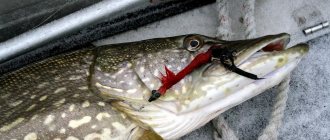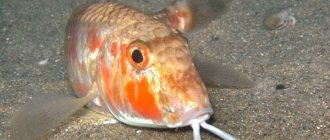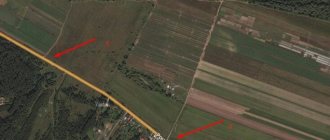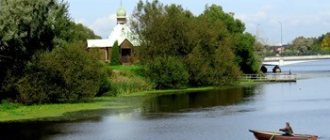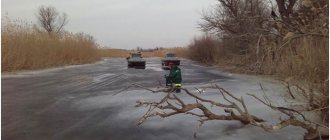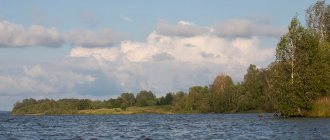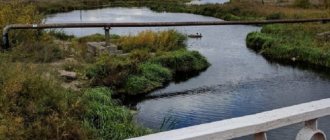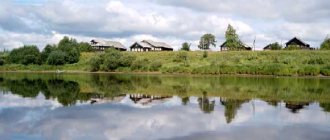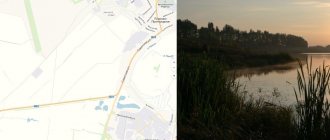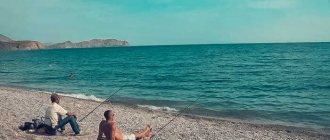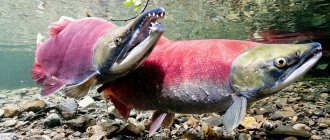The Dubna River is famous for its abundance of fishing spots and good bite. All year round, the mighty river with a wide variety of fish and all kinds of fishing conditions attracts amateur and professional fishermen.
The river passes through the Vladimir, Moscow, and a little Tver regions. Occupies the right side of the Volga River. Passing between the settlements of Zazevitovo, Karely. Near the city of Alexandrov, on the slopes of the Klinsko-Dmitrovsky ridge. Takes the original direction to the west. In the Moscow region, near the village of Filisovo, it turns to the north.
Further, after connecting with Sulati, it rushes in a southwestern direction. Six kilometers later, above the village of Verbilok, it abruptly changes its course to the northwest. It is navigable from the village of Berezhok to the lower reaches for more than 15 km. It flows into the Volga, from the eastern side of the city, more than 8 km below the Ivankovskaya dam. Left tributaries: Kunya, Velya, Sestra, Kubzha. Right tributaries: Hotcha, Sulat.
The Dubna River has:
- width: 40–70 m;
- depth: 2–4 m;
- length: 169 km;
- basin area: 5460 km².
Features of fishing in Dubna by fishing season
- The spring months are the best for fishing because at this time all the fish from the Volga River go to spawn. And then you can, without much difficulty, catch: chub, asp, ide, dace, perch, pike and even catfish. From the end of May, ide and chub are especially active.
- In the summer , the fish bite well: dace, burbot, perch, pike, asp. From the beginning of May to August inclusive, more successful fishing will be at night or at dawn. When hot days come, the fish becomes passive, so they bite reluctantly during the day.
- In the fall , all types of fish begin to eat, they prepare for a cold and hungry difficult time - winter. Good catch: ide, catfish, pike perch, roach, asp, pike, crucian carp.
- In the winter season , in severe frosts, there is almost no bite. Ideal winter weather is a frosty morning, but without wind or snow. If the temperature rises or drops sharply, you should avoid going fishing.
With the arrival of the first snow, silver bream begins to be caught very well. In the cold season, you can hunt for pike, silver bream, crucian carp, bream, and asp.
When the river is covered with ice, for successful fishing, use only those fishing rods that are intended for winter fishing, and no more than 1 m in length. And it will be more productive to fish at maximum depth.
Summer fishing
During the open water season, a variety of tackle and bait are used on the reservoirs of Dubna and the surrounding area - from a simple float rod with a chatterbox on a hook to a feeder with a sandwich of bloodworms and maggots.
Tackle
In summer, on the reservoirs of Dubna and its environs, the following gear is used:
- Feeders - when fishing on the Ivankovo Reservoir and the Volga, they use rods 3.6-3.9 m long with dough up to 120 g, while on Dubna and the Moscow Canal, forms 3.0-3.3 m long are more convenient.
- Float fishing rod - on the Volga and Reservoir, Bolognese fishing rods with spinning reels and current-resistant spindle-shaped floats. In stagnant water of bays and oxbow lakes, on Swan Lake, fly forms with blind rigging and more sensitive and lightweight floats are used.
- Spinning - in backwaters, old rivers and channels, predators are caught using ultralight or light spinning tackle with a weight of up to 15 g. For fishing on the river reaches of the Volga, hard heavy class spinning rods with a weight of 10-15 to 30 g are used.
- Mugs for catching pike, pike perch or carp
Lures
The choice of bait depends on the fishing season:
- In early spring (March-April) and late autumn in the reservoirs of Dubna and the surrounding area, baits such as dung worms, bloodworms, and maggots are more catchy.
- From the end of spring to the beginning of autumn, vegetable baits are also actively used - semolina, mastyrka, canned corn.
Best places for fishing
- The best place is the mouth of Dubna , at this point the river connects with the Volga. And very close, near the city of Dubna, there is the Uglich Reservoir. Therefore, in this place the water flow is slower and the river is much wider.
- Another good place is not far from the railway bridge . If you look a little above the bridge and along the river, you can see large riffles. When you go down, a little more than a kilometer, you can see smaller streams of rapids. This is where you need to stop!
- The reaches are located in Yudino-Starikovo , downstream, and pike are excellently caught here.
- There is a road bridge across Dubna. If you walk a little upstream from the bridge (about 2 km), you will come across a bend where you can get a good deal of pike, chub, and perch.
- A promising location is near Verbilki station.
Fishing in Dubna
6 minutes Author: Sergey Elin 1658
Fishing in Dubna is one of the favorite pastimes of both local fishing enthusiasts and numerous visitors from neighboring regions. The popularity of such recreation is due to the large number of different bodies of water both in the city itself and in small settlements located near it. At the same time, the different size and type of reservoirs allows anyone to choose the most comfortable fishing conditions for him - from the vast expanses of the Ivankovo Reservoir, the deep and wide Moscow Canal, to the small Dubna River flowing into the Volga, the compact Lebyazhye Lake, the Volga backwaters and oxbow lakes.
More details about the fishing spots of this small town and its environs, the gear and bait used on them will be discussed in this article.
What gear is best to use?
It is better to use ultralight spinning rods :
- dough 1-7 g;
- dough 7-20 gr.
For bait take:
- rotating spoons, with sizes No. 0-2;
- sinking wobblers;
- small vibrations.
Jig fishing has also proven itself well. With a combined silicone bait and a rotating petal for insects. Particularly effective for ide and chub.
A paired spinning rod, otherwise called a baler, is a tackle for catching fish that feed directly at the water surface.
Local fishermen use the following gear to catch chub:
- bale;
- boat
But it can get into it: ide, perch.
Fly fishing also has its admirers. And far from unsuccessful. They also hunt dace, roach and silver bream. Where the water flow is most intense, it is better to fish with bottom gear and spinning rods.
In winter they hunt:
- heavy jigs;
- zherlitsa.
You should only fish bait Fish must not only be attracted to the fishing zone, but also retained. It is better to feed with store-bought sports bait. But you can make a good one at home.
Float rod
Some floaters close the season with the first autumn cold snap. It is believed that the fish become less active and go deeper. But more experienced fishermen prove the opposite.
In October and November, fishing is more reasonable and the catch is larger. To catch bream or crucian carp on a fishing rod, the place is first baited. For bait they take: worms, maggots, bloodworms.
Roaches readily eat boiled pearl barley and worms. The bream is not large, but it takes it steadily. It's better to choose a place:
- in the so-called coastal edge;
- on sand spits;
- near the dam.
Spinning
To get a faster result, in search of fish you need to comb using trolling, a GPS navigator, deep edges with an echo sounder. You can also use slow trolling in shallow water:
- paths with an abundance of silver fish on leashes;
- at the end there is a large popper.
Pike prefer spinners; they are probably more tasty for them. Especially the Finnish “Blue Fox Super Vibrax” No. 3,4.
When hunting for spinner, retrieve speed will be of paramount importance. The movements of the spinning spoon are so measured and slow that with a weak bite sometimes the blade of the spoon breaks and spins.
In shallow sandy bays, perch, silver bream and pike can actually be provoked to attack if the lure periodically touches the bottom. A rising cloud of turbidity will provoke large and predatory fish to bite. Small fish create the same cloud when feeding.
In shallow water - wobblers, less than a meter deep and spinners No. 0.1, you can profit from pike and perch.
In the current, when moving the turntable in a measured manner, you need to periodically make sudden movements every 5-6 turns. The amplitude is no more (20-30 cm). This will force the spinner to play. Wiring during currents can be made even slower. Because the spoon spins, even if it stands still.
If you can’t tempt the fish into a monotonous retrieve, then you need to try to make repeated accelerations, by 4-6 turns of the reel. You can move the spinning rod a little from side to side. Create an approximate trajectory for the bait.
It is good to fish with spinning rods in summer and early autumn.
Feeder
The feeder is essentially an English donka, a universal tackle. A feeder is a rod with interchangeable tips. If it bends when biting, then you need to hook. They choose their tips for a certain type of fish; they differ in hardness.
The feeder consists of 3 parts:
- butt;
- basic;
- signal
For different fishing conditions, you need to select rods with different action and test accordingly. The feeder has a feeder, it can be of various shapes and sizes. The feeder must be equipped with a reel and braided fishing line.
If you fish near a dam at depth, then you need:
- closed feeder;
- powerful feeder, up to 180 g;
- build 4 hardness.
When the current is small and the depth is shallow, a reel with a baitrunner is suitable.
Before fishing, you need to determine the depth and select the appropriate distance. And find a more or less level bottom. When you find the fishing point, start feeding. Give a couple of feeders with bait, and then lower the main one to catch!
Donka
The bottom fishing rod is good, especially when catching: perch, chub, dace. Rod of choice:
- shortened but powerful;
- no more than 2 m long;
- with inertial coil;
- fishing line from 0.16-0.2 mm;
- flat sinker;
- single hook.
If you use live bait for bait, then the equipment should have two hooks. Because the chub will attack the bait from its tail. The hook must be energetic and short.
Fishing places
All fishing spots can be divided into two categories - located within the city limits and in the vicinity of Dubna (in nearby settlements of various sizes).
Within the city limits
The most popular fishing spots within the city are the section of the river near the road bridge, Lebyazhye Lake, Ivankovskoye Reservoir, the Moscow Canal, and the First Technical Bay.
Volga under Dubnensky Bridge
After the construction of the Dubnensky automobile bridge in the fall of 2021, the section of the Volga upstream and downstream has become very popular among local fishermen. The river in this place has a width of 3500-400 m, a depth of 4-5 to 6-8 m, and in some places up to 12 m. The bottom is clayey with a slight silt, and colonies of shells are often found. Along relatively flat shores overgrown with bushes and trees, there are extensive sandy and sandy-pebble shallows.
The main inhabitants of the underwater world of this section of the Volga are large and medium-sized bream, pike perch, asp, roach, trophy pike, medium-sized perch, silver bream, and willow bleak.
Lake Lebyazhye
Lake Lebyazhye is an artificial reservoir formed on the site of a quarry, the clay extracted from which was used to strengthen the coastal embankment of the Moscow Canal. Flooded over time by atmospheric and groundwater, this man-made depression turned into a picturesque lake 1075 m long and up to 500-525 m wide. Despite the long-term extraction of clay, the lake is shallow - its average depth of the reservoir is 1-1.5 meters. At the same time, in some places there are 3.5-4 meter holes.
The lake is home to such species of fish as crucian carp, tench, pike, perch, and burbot. Cancer also occurs.
This reservoir is located on the southwestern outskirts of the city near the Bolshaya Volga station. It is separated from the Moscow Canal by a small embankment.
Since in summer the reservoir is very noisy and crowded, and there is practically no place to pitch a camp with a tent, many stop at the nearby fishing base “Big Volga”.
The water level in Lebyazhye Lake is on average a meter higher than in the nearby canal and reservoir. This is explained by the large number of springs gushing at its bottom, constantly feeding and often overflowing the lake. This feature of the lake led to the fact that it was necessary to raise the highway passing through it several times and lay special drainage pipes under it.
Ivankovskoye Reservoir
Located partly within the city limits, this valley-type reservoir has a length of more than 120 km and a maximum width of 12 km. The average depth of the reservoir is 4 m, the maximum is 18-19 m.
The species composition of the fish kingdom of the reservoir is very diverse - it is home to a lot of carp and perch, grass carp, silver carp, eel, and peled are found here.
Moscow Canal
In the southern part of the city there is a large section of the Moscow Canal connected to the Ivanovo Reservoir and the Volga River. It has fairly flat and clean banks, a bottom topography typical of shipping canals - sharp coastal slopes extending from the water's edge to the center of the canal, forming a deep channel ditch in the central part of the canal, intended for navigation. The bottom is covered with very large stones and boulders.
The depth of the channel in the channel ditch reaches 8-10 m, near the shore it changes sharply from 1.5-2 to 3-4 m. The reservoir is rich in fish - there is a lot of bream, roach, silver bream, pike perch, asp, pike, perch.
First technical bay
Located at the confluence of the Moscow Canal and the Ivankovo Reservoir, this bay is about 3 km long and more than 1 km wide. Quite shallow, it has a bowl-shaped bottom relief with banks located along the outskirts with a depth of up to 1.5-2.0 m and the deepest central part, where the depth reaches 4-4.5 m.
The bay is inhabited mainly by medium and small fish - white bream, bream, silver bream, roach, pike, perch.
In the vicinity of the city
Fishing on the Dubna River, a right tributary of the Volga, flows into it a few kilometers from the city, is very interesting and catchy. The most fishy and frequently visited sections of this small river are located in such settlements as:
- Verbilki station;
- Pritykino;
- Yurkino;
- Ustye-Strelka;
- Ratmino;
- Starikovo;
- Sushchevo;
- Votrya.
Best lures
Best lures:
- Spoons No. 1 or No. 2.
- Wobblers, only preferably in bright colors. Based on characteristics, choose only sinking ones. Particularly suitable for predatory fish, especially pike.
- Dough.
- Worms.
- Maggots.
- Bloodworms.
- Insects.
Good fishing for insects: carp, ide, dace, perch. Especially in spring and early summer. It is good to catch small fish using chicken liver. There are even trophy specimens.
It is better to combine baits.
When using silicone baits, you need to take care of the desired aroma in advance. It must be strong enough to attract aquatic life from afar.
The best places, features and methods of fishing on the Dubna River
The Dubna River is famous for its abundance of fishing spots and good bite. All year round, the mighty river with a wide variety of fish and all kinds of fishing conditions attracts amateur and professional fishermen.
The river passes through the Vladimir, Moscow, and a little Tver regions. Occupies the right side of the Volga River. Passing between the settlements of Zazevitovo, Karely. Near the city of Alexandrov, on the slopes of the Klinsko-Dmitrovsky ridge. Takes the original direction to the west. In the Moscow region, near the village of Filisovo, it turns to the north.
Winter fishing on Dubna
Winter weather is a fundamental success factor. If it doesn’t exist, then even the coolest place won’t help. Lack of weather is:
- unstable frost, which may be replaced by a thaw;
- pressure surges;
- short-term snowfalls.
Winter fishing is a completely different philosophy. Fishing is more difficult in winter than in summer, so anglers must be patient. You can get a good catch if you go hunting on the first or last ice. Bait in winter - maggots and small bloodworms.
River Riffle
River riffles are the best place for winter fishing, because small fish come out to feed there. She eats food carried away by water flows. And predatory fish species at this time hunt for peaceful fish.
On the rifts, the fish gather in certain places, and come out to feed only at a known time. The structure of the riffle is typical, it has:
- pressure slope;
- saddle;
- crest;
- basement
That is why the conditions cannot be accurately described. There are only general principles: if you drill holes downstream, you can reach any point. Monitor the speed of water flow and changes in depth. And then you can understand whether this place is promising or not.
A promising place for ide and carp is the mow behind the ridge. Dace and silver bream are caught on the slope of the ridge, with a faster current. Downstream, on the saddle, there are perches.
When ice fishing, a good place on the lower part of the river is the mouth. During the freeze-up period, you can catch perch, roach, silver bream, and bream.
Features of winter fishing.
The main features of fishing in Dubna in winter:
- Activity is observed in many species of fish.
- There is the possibility of free movement across the pond.
- In severe frosts, there is usually no bite.
- It is more advisable to look for areas with moderate currents.
- The best weather is a frosty morning, most importantly, without snow and strong wind.
It must be remembered that when there are sudden changes in pressure, it is better to give up fishing altogether, since the fish are extremely passive.
During the cold season you can successfully fish for:
An important point: with the arrival of the first snow, the silver bream is caught much faster.
The reservoir freezes completely and fishing is done from the ice. Only winter fishing rods should be used, with the rod within one meter. It has been noted that the bite on wobblers, spinners, and small fish is much more effective.
Important advice: for a fruitful catch, you need to give preference to areas with the greatest depth.
Reviews from anglers
Mikhail, 35 years old: “This summer I was able to fish on this river for the first time. I took a sharp turn, not far from Verbilki. I caught a huge crucian carp on the feeder. The current was quite strong, and it was mainly bream and small roach that were clinging. Having caught a crucian carp, I was, of course, surprised, I guess I was lucky!”
Vladimir, 28 years old: “After waiting for the weekend, I went to the river myself, near the village of Sushchevo. I sat at the bridge for an hour and a half and didn’t see a single bite. I walked a little further, about 400 meters from the bridge. I cast my fishing rod and wait. The bite came almost immediately. And I caught a bream using an ordinary worm. I enjoyed nature for more than two hours. But there was no more bite. Then small perches began to appear, I immediately released them. And with a calm soul he went home. I am for a healthy lifestyle!"
Vasily , 46 years old: “With skillful dexterity and a well-chosen place, you will definitely not be left without a catch!”
